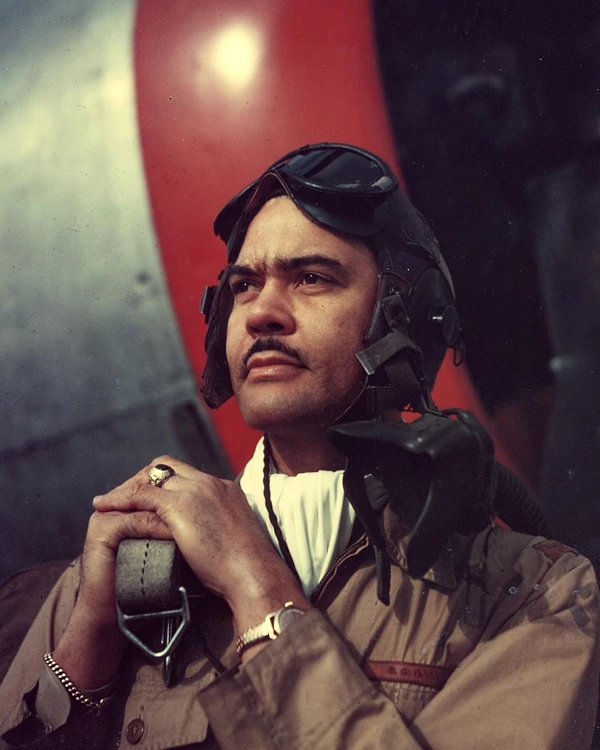Last updated: February 13, 2025
Person
Benjamin O. Davis Jr.

National Air and Space Museum, Smithsonian Institution
Benjamin Oliver Davis, Jr., was born on December 18, 1912, in Washington, D.C. He was the second of Benjamin O. Davis, Sr., and Elnora Dickerson Davis’s three children. Davis, Sr., was a U.S. Army officer and became the first African American to earn the rank of brigadier general in the U.S. Army. Elnora Davis died in 1916 from complications of childbirth.
Davis, Jr., and his family lived in Washington, D.C. while his father was deployed in the Philippines starting in 1917. The family was reunited in 1920 when Davis, Sr., was stationed at Tuskegee Institute in Alabama where he taught military science and tactics, precursor to the modern-day ROTC. They then moved to Cleveland, Ohio, in 1924, when the senior Davis was assigned as an instructor to a federalized Ohio National Guard unit. Davis, Jr., graduated from Cleveland’s Central High School in 1929. He attended Western Reserve University and the University of Chicago before entering West Point in 1932.
Like the African American cadets before him, Davis, Jr. suffered from the racism that prevailed at the academy. White cadets excluded him from activities because of his race. He lived by himself and ate his meals in silence since no white cadets would talk to him. Nevertheless, he persevered and graduated from West Point in 1936 in the top 20 percent of his class (Class Placement 33). He was the fourth African American to graduate from the academy. Reflecting on his time at West Point, Davis, Jr., said “It was designed to make me buckle, but I refused to buckle. They didn’t understand that I was going to stay there, and I was going to graduate. I was not missing anything by not associating with them. They were missing a great deal by not knowing me.”
Although Davis, Jr. wanted to be an Army aviator, there were no all-Black aviation units at that time, so he was assigned to the Twenty-fourth Infantry at Fort Benning Georgia. In that era, African Americans were restricted to serving in the four all-Black regiments that were known as the Buffalo Soldiers. During that time, he led a company of soldiers and attended infantry school.
In June 1938, Davis, Jr., was assigned to Tuskegee Institute as professor of military science and tactics, the position his father held 18 years earlier. He served at Tuskegee until February 1941 when his father, then a brigadier general, transferred him to his staff at Fort Riley as part of the 4th Cavalry Brigade that encompassed the 9th and 10th Cavalry regiments.
Davis, Jr.’s assignment as his father’s aide at Fort Riley lasted only four months. General Davis, Sr., received a letter from the Chief of the Air Corps requesting that his son should transfer to the Tuskegee Army Airfield for pilot training. Davis, Sr., quickly approved the transfer.
Davis. Jr., now an Army captain, accepted the position; he began ground training at Tuskegee Institute in July 1941. He, along with 12 other aviation cadets, comprised the first class that would later be known as the Tuskegee Airmen. In March 1942, Davis, Jr., graduated and earned his wings. In May, he was promoted to lieutenant colonel and transferred to the Army Air Corps as part of the expansion and mobilization effort after the United States entered World War II.
In August 1942, Davis, Jr., was made the commander of the 99th Fighter Squadron at Tuskegee Army Airfield. He and his men continued to train in Tuskegee until March 1943 when they received word that they were officially being deployed in April.
The 99th Squadron made its way to Camp Shanks, New York, to await passage aboard the SS Mariposa. They left the docks in Brooklyn, New York, on April 15, sailing to North Africa. Operating out of Tunisia, the 99th first saw combat on June 2, during Operation Corkscrew, in which they targeted enemy positions on the German-held Italian island of Pantelleria in a successful dive-bombing raid.
Davis, Jr., returned to the United States in the fall of that year to take command of the 332nd Fighter Group. While in Washington, he successfully defended the 99th Squadron in the halls of the Pentagon against accusations of incompetence and calls for its dissolution. He and the 332nd then deployed to Italy two months later.
The 332nd Fighter Group, stationed at Ramitelli Airfield, consisted of four fighter squadrons. The fighter group earned the nickname “Red Tails” because of the distinctive markings on their planes. It amassed an impressive record of protecting bombers on missions deep inside Germany. It was awarded the Distinguished Unit Citation for its mission on March 24, 1945, when they protected bombers on their way to Berlin.
After the war, Davis, Jr., assumed command of the 477th Composite Group at Godman Field, Kentucky. He held progressively higher commands throughout his career, eventually attaining the rank of lieutenant general before retiring from the U.S. Air Force on February 1, 1970.
General Benjamin O. Davis, Jr., was promoted to four-star general by President Bill Clinton on December 9, 1998. He died on July 4, 2002, at the age of 89. He was buried at Arlington National Cemetery Section 2, Grave E-311-RH.
